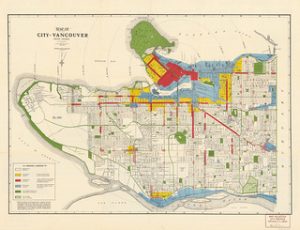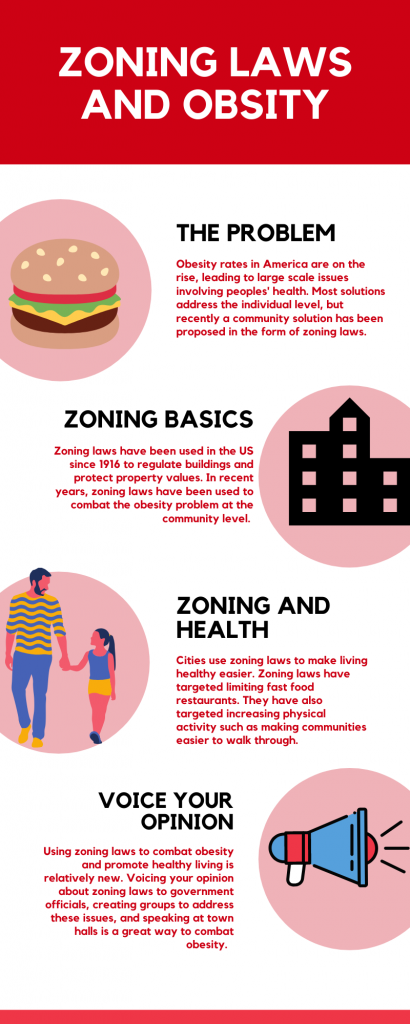21 Zoning Laws and Obesity
Zach Harley
Government Legislation
With the obesity rate steadily rising in America, many people across numerous fields study the reasoning behind why these rates have been increasing. Scientists, government officials, and even concerned citizens study why obesity rates are on the rise, while also investigating ways to help fight this problem. Through their research and efforts to bring about change, the overall health of America has the chance to improve. Several methods and measures have been taken to educate people about obesity and improve the nation’s state of health. Such measures include increasing peoples’ education about obesity, creating awareness of simple methods of fighting obesity such as proper diet and exercise, and even creating legislation to promote awareness of how much people are eating. However, fighting obesity can go beyond targeting the individual. Local governments can target issues of access to healthy food and places to exercise through several laws and legislations (Chen & Florax, 2010). One form of legislation governments can use is zoning laws.
Background on Zoning
According to the Encyclopedia Britannica (2013), zoning is “the legislative method of controlling land use by regulating such considerations as the type of buildings (e.g., commercial or residential) that may be erected and the population density.” In other words, zoning laws allow governments to regulate what developers can use land for based on factors such as the population density in a given area. In Europe, the idea of zoning laws arose beginning in the late 1800s as a way to control crowding and uniformity (Editors of Encyclopedia Britannica, 2013). However, it would be several years later before the United States adopted zoning laws to regulate buildings. In 1916, New York City established the first zoning laws in response to the construction of a large office building that blocked smaller buildings and the street below from receiving sunshine and airflow (YR Architecture Design, n.d.). Below is a video that further introduces and discusses zoning.
“An Introduction to Zoning,” by City Beautiful is in the Public Domain, CC
Zoning Laws and Community Health
A lot of time has passed since zoning laws were first established in New York City. As a result, legislators have added and adapted these laws to regulate aspects of construction such as building height, floor area ratio, lot coverage, easements, and setbacks. Ultimately, the goal of zoning laws is to protect property values by establishing rules and regulations about what can be built where (YR Architecture Design, n.d.). However, recently local governments have begun to experiment with zoning laws as a way to combat the obesity problem in the United States. According to Chen and Florax (2010), the literature shows that neighborhood factors, such as access to healthy foods, associate with obesity levels. Therefore, some communities have experimented with zoning laws to try and make an impact on obesity rates. One such experiment occurred in California. In 2008, zoning laws banned the construction of new stand-alone fast food stores in southern Los Angeles. However, four years later, there seemed to be no substantial, short-term impacts (Sturm & Hattori, 2015). This data does not suggest that zoning laws are useless in combating obesity. Instead, zoning laws can serve as a way to limit access to unhealthy food options while also allowing cities to promote healthy living.

Parlow (2017) explains this concept further by describing how cities use policies to promote healthy living. One such policy in place is New Urbanization. New Urbanization is the practice of zoning cities in a way that promotes physical activity by eliminating the need to travel by car. In turn, New Urbanization promotes exercising and healthier lifestyles. In 2015, the Surgeon General released a call to action called “Step It Up!” calling attention to the obesity problem and how areas can increase walkability to promote healthier living (Office of the Surgeon General, 2015). Furthermore, some cities such as Richmond, California are beginning to add elements into their general plans to address health problems like obesity through the physical environment (Parlow, 2017). By addressing health issues in city planning, it is easier for people to make healthier choices, especially regarding obesity. Research does show that the effectiveness of zoning policies relies on the ability to identify where these policies are needed most (Chen & Florax, 2010). For example, current evidence suggests that less zoning laws to combat obesity and improve healthy living exist in low-income and rural areas when compared to high-income areas (Taber et al., 2016). Therefore, increasing zoning laws in these areas, or changing them, could be effective.
Summary
The rise of obesity rates in America have led to the search for solutions, with many focusing on individual lifestyles. However, the nontraditional use of zoning laws allows the fight for healthy living to exist at community levels. Communities can use zoning laws to limit unhealthy options such as fast food restaurants while promoting healthy living through policies such as New Urbanization. If someone is concerned about zoning issues in their areas, they can contact their local government officials, look for or create a group addressing these issues, or attend town or city meetings to voice concerns and help bring awareness to this issue. Although current research shows that zoning laws have the potential to help people live healthier lives, more research is required to view the true impact of zoning laws on the obesity problem in America. The following infographic is a summary of this issue.

Review Questions
1. In the United States, when did zoning laws first start being used?
a. The late 1800s
b. 1916
c. 1920
2. What is the ultimate goal of zoning laws?
a. Protect property values
b. Control crowding and uniformity
c. Promote healthier living
3. What was the specific target of the Surgeon General’s 2015 call to action?
a. Regulate the building of fast food chains
b. Increase access to healthy food markets
c. Increase walkability to promote healthier living
References
Chen, S. E., & Florax, R. J. G. M. (2010). Zoning for health: The obesity epidemic and opportunities for local policy intervention. The Journal of Nutrition, 140(6), 1181S-1184S. https://doi.org/10.3945/jn.109.111336
The Editors of Encylopedia Britannica. (2013, September 11). Zoning. Encylopedia Britannica. https://www.britannica.com/topic/zoning-land-use
Office of the Surgeon General. (2015). Executive summary from step it up!: Surgeon general’s call to action. https://www.hhs.gov/surgeongeneral/reports-and-publications/physical-activity-nutrition/walking-executive-summary/index.html
Parlow, M. J. (2017). Healthy Zoning. Fordham Urban Law Journal, 44(1), 33–58. https://ir.lawnet.fordham.edu/ulj/vol44/iss1/2/
Sturm, R., & Hattori, A. (2015). Diet and obesity in Los Angeles County 2007-2012: Is there a measureable effect of the 2008 “fast-food ban:? Social Science & Medicine, 133, 205-211. https://doi.org/10.1016/j.socscimed.2015.03.004
Taber, D. R., Chriqui, J. F., Quinn, C. M., Rimkus, L. M., & Chaloupka, F. J. (2016). Cross-sector analysis of socioeconomic, racial/ethnic, and urban/rural disparaties in food policy and enactment in the United States. Health & Place, 42, 47-53. https://doi.org/10.1016/j.healthplace.2016.08.006
YR Architecture Design. (n.d.). Zoning 101: Understanding zoning laws. http://www.yr-architecture.com/zoning-101-understanding-zoning-laws/
the number of people living in each unit of area (such as a square mile)
presenting an unvaried appearance of surface, pattern, or color
the maximum vertical distance from the average ground level at the front wall of the building to the highest point of the structure
YR Architecture Design. (n.d.). Zoning 101: Understanding zoning laws. http://www.yr-architecture.com/zoning-101-understanding-zoning-laws/
the ratio of total building floor area (including all floor levels) to the area of the lot
YR Architecture Design. (n.d.). Zoning 101: Understanding zoning laws. http://www.yr-architecture.com/zoning-101-understanding-zoning-laws/
s the allowable percentage of a lot that may be occupied by built structures and paving
YR Architecture Design. (n.d.). Zoning 101: Understanding zoning laws. http://www.yr-architecture.com/zoning-101-understanding-zoning-laws/
a legal right to use another’s land for a specific limited purpose (i.e. underground utility lines)
YR Architecture Design. (n.d.). Zoning 101: Understanding zoning laws. http://www.yr-architecture.com/zoning-101-understanding-zoning-laws/
required minimum distances structures must be “set back” from lot lines
YR Architecture Design. (n.d.). Zoning 101: Understanding zoning laws. http://www.yr-architecture.com/zoning-101-understanding-zoning-laws/
the ability to be capable of or suitable for being walked

